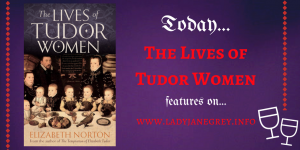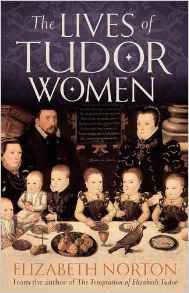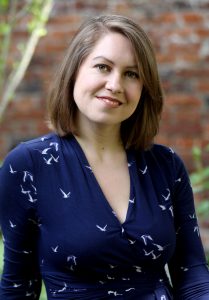I am delighted to host the second stop on the virtual blog tour to celebrate the UK publication of ‘The Lives of Tudor Women’ by Elizabeth Norton.
You can buy it from:
Thank you to Elizabeth for this guest article.
Tudor Women and Religion
Henry VIII had little time for women who involved themselves prominently in religion, as the warrant of arrest drawn up for his sixth wife, Catherine Parr, in 1546 on a charge of heresy shows. He had previously been thwarted in his attempts to put Elizabeth Barton, the Nun of Kent, on trial for treason in 1533, due to the fact that all the judges considered she could not possibly be found guilty: she had, after all, actually told the king to his face everything she was accused of disseminating.
Such a legal opinion failed to save the Kent prophetess’s life, since Henry then resolved to proceed against her by Act of Attainder. Nonetheless, the ‘hypocrite nun’ had proved to be a considerable annoyance. Even Archbishop Cranmer believed that, due to her direct contact with the pope’s ambassadors, as well as Cardinal Wolsey, Archbishop Warham, Bishop Fisher and Thomas More, she had greatly delayed the annulment of the king’s marriage to Catherine of Aragon. Barton was hanged on 20 April 1534, but she was not the last woman to trouble him in the cause of religion.
The Act for the Advancement of True Religion, which was passed by parliament on 12 May 1543 made it illegal for women below the rank of noblewoman or gentlewoman to read the Bible in English, while those upper class women still permitted to continue, were required to read only in private. Great swathes of Englishwomen were suddenly criminalised; but many kept on reading either at home or in public.
The Reformation and the dissemination of the scriptures in English had been eye-opening for an entire generation of women. Decades later, at the end of her long life, the merchant’s daughter Rose Hickman would recall that, during the heady days of the 1530s and 1540s, she had learned of Protestantism at her mother’s knee. The elder woman would send secretly for reformist texts from overseas and ‘used to call me with my 2 sisters into her chamber to read to us out of the same good books very privately for fear of trouble because these good books were then accounted heretical’. There was danger in such activities, but Englishwomen kept on reading.
Joan Bocher was one such woman. She appears suddenly in the records in the 1540s, when she was already in trouble for her fervent religious beliefs. Her early life is obscure. She had a husband at one time, living with him in the tiny hamlet of Westbere, which lay a few miles from Canterbury in Kent. Even then, thanks to her reading of the Bible and the contact that she had with others who held reformist beliefs, she had become convinced of the new ways. She was certainly well travelled. Perhaps her husband was a merchant, which would account for why she was able to move around more widely in England than others of her class. She was no gentlewoman, but she could read and write and had a good understanding.
Joan did not have to wait for Henry VIII’s Great Bible of 1539, which was the first authorised English translation. She had already obtained a copy of the ‘heretical’ Tyndale English New Testament. She became noted as ‘a great reader of Scriptures’, and soon was a great disseminator too. Bocher was later charged with being ‘the principal instrument’ by which Tyndale’s Bibles were distributed when they arrived in England, smuggled in bales of cloth. Her new faith brought her connections to some of the more influential and religiously radical women of the court, and she made herself useful to them: taking up several New Testaments at once, she carefully bound them with string beneath the layers of her dress, before boldly walking into court with her hidden wares, where they were hurriedly distributed.
Joan was right to be covert. England, in the 1530s, was still led by a king who considered himself largely traditional in his beliefs. Once, at Colchester, Joan was required to publicly abjure her faith, returning to the traditional church of her youth. She soon abjured her abjuration.
By the late 1540s or early 1541, Joan Bocher was living in Frittenden, close to her former parish. She was as bluntly outspoken as ever, declaring on one occasion that ‘matins and evensong was no better than rumbling of tubs’. On being evicted by her landlord, she packed up her belongings and made for Canterbury, lodging in the house of the radical John Toftes in the Westgate area of the city. There, she lived amongst many of the king’s most extreme subjects, including the Parson of Hothfield, who claimed that the Virgin was neither the queen of Heaven, not more important than any other woman, being only the ‘bag’ in which Christ grew. Joan, for her own part, caused trouble when, on Easter morning, she prepared a calf’s head for breakfast – feasting when she should have been fasting. She can only have intended to provoke and in late 1540 or early 1541 she was arrested for heresy.
Joan did not deny her heresy when questioned, declaring in a signed confession that she refuted the miracle of the transubstantiation: the bread and wine of the sacrament were not, she asserted, transformed into the body and blood of Christ. She remained for two years in prison before being released only through the ministrations of Christopher Nevinson, Archbishop Cranmer’s commissary, who probably acted on the instructions of his employer. Even Cranmer found some of Joan’s behaviour ‘offensive’, but on this occasion he protected his co-religionist.
Joan was fortunate and spent the rest of Henry VIII’s reign in obscurity. Anne Askew, a woman with whom Joan shared her ‘nearest friendship’ was less fortunate. This Lincolnshire gentlewoman was thrown out of her home by her husband after (as she claimed) ‘she ‘fell clearly from all old superstition of papistry, to a perfect belief in Jesus Christ’. Anne, as a gentlewoman, was legally permitted to read the Bible in English at home, but she provoked outrage when she was found reading the scriptures in Lincoln Cathedral soon afterwards, being surrounded by ‘three score priests’. Determined, as she said, ‘that all men knew my conversation and living in all points’, she resolved to go to London.
Anne Askew was soon in contact with many of the more radical women at the English court, including the Duchess of Suffolk and the Countess of Hertford. She probably also knew the queen, Catherine Parr. She continued as outspoken as ever in the capital and was, unsurprisingly, arrested in March 1545, accused of denying the miracle of the sacrament. When interrogated, Anne was cocky, self-assured, bold, quoting the scriptures and evading anything too incriminating. When asked whether she had the spirit of God within her, she answered: ‘if I had not, I was but a reprobate or cast away’.
On this occasion, she was eventually released, but she was rearrested in May the following year. At her trial on 18 June 1546 Anne admitted that she did indeed deny the transubstantiation: ‘as for that ye call your God, is but a piece of bread. For a more proof thereof (mark it when ye list) let it lie in the box but three months, and it will be mould, and that it cannot be God’. She was sentenced to burn, but not before being tortured in the Tower for what information she could give on the queen and the other court ladies.
The death of Henry VIII in January 1547 cleared the way for the Protestant regime of Protector Somerset, allowing women to be more open in their faith. For many, such as Catherine Parr and her protégés, the future Elizabeth I and Jane Grey, it was a time of enlightenment, when they could be open about their faith. In an era where there was little concept of religious tolerance, however, the regime change was devastating to some. The Catholic Princess Mary, concerned about the restrictions being placed on her own worship, came close to taking ship to Flanders.
Even Joan Bocher found herself out of step with the new regime. By the late 1540s, she had moved on in her beliefs, holding the radical view (as Cranmer would put it to her) ‘that the Word was made flesh in the Virgin’s belly; but that Christ took flesh of the Virgin you believe not, because the flesh of the Virgin, being the outward man, was sinfully gotten, and born in sin. But the Word, by the consent of the inward man of the Virgin, was made flesh’. Joan Bocher had the misfortune – on 2 May 1550 – to become one of only two people burned for heresy under Edward VI.
The swinging pendulum of religious change under the Tudors hit women as much as men. Jane Grey – the Protestant alternative to the Catholic Mary I – was another victim, as were the Protestants who died under Mary I and the Catholics under Elizabeth I. Yet, at the same time, for many it was a time of great discovery. For Rose Hickman, reading quietly in her mother’s chamber for fear of discovery, the publication of the scriptures in English for the first time allowed women (who were rarely taught Latin or Greek) to consider and think about religion. For many, it was a revelation.
Follow Elizabeth on Social Media:
Elizabeth’s website: Elizabeth Norton
Twitter: @ENortonHistory
Facebook: Elizabeth Norton




































